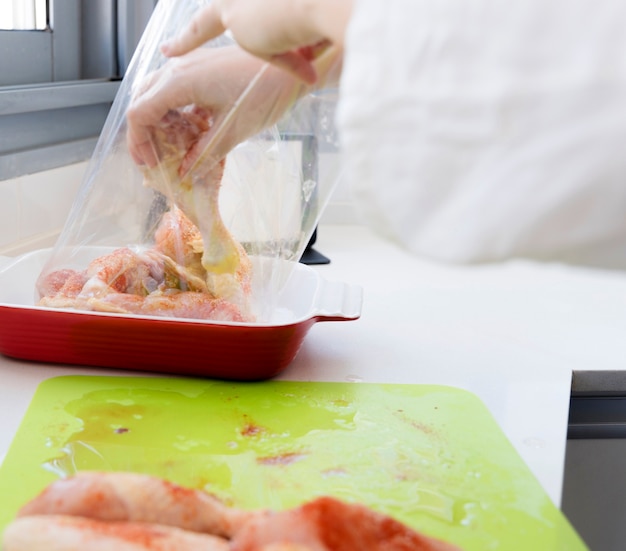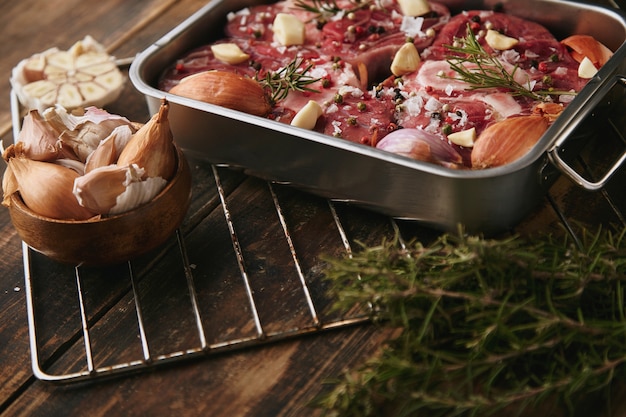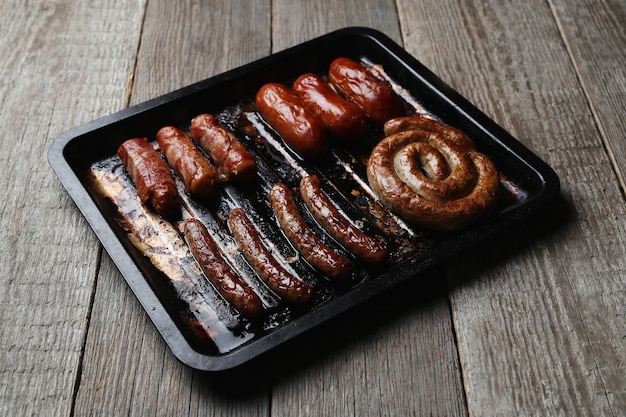Let's talk about bacon, the breakfast (or any meal, really) hero that has a special place in our hearts. As a passionate bacon enthusiast, I've spent countless hours (and devoured countless rashers) perfecting my oven-baked bacon technique. Through trial and error, I've experimented with every temperature imaginable, from blazing hot to lukewarm. My journey has taught me a thing or two about achieving that crispy, golden-brown bacon heaven. So, grab a cuppa, settle in, and let me share my secrets to unlocking the perfect oven-baked bacon experience.
(Part 1) Why Oven-Baked?

Now, you might be wondering, "Why go through the hassle of oven-baking bacon when I can just throw it in a pan?" Trust me, my friend, oven-baked bacon is a game-changer. It's a much cleaner way to cook it, as you won't be dealing with splattering grease all over your stovetop. Plus, you can cook a whole lot more bacon at once, which is ideal for those weekend brunches or family gatherings. And let's be honest, there's something undeniably satisfying about opening the oven and being greeted by the divine aroma of sizzling bacon. But there's more to it than just convenience.
The Science Behind Oven-Baked Bacon
Oven-baking bacon isn't just a culinary shortcut; it's a science-backed approach to achieving the perfect texture. The even heat distribution of the oven ensures your bacon cooks evenly, resulting in those perfectly crisp edges and a tender, juicy center. It also helps prevent overcooking, which can leave you with rubbery, unpleasant bacon. It's all about finding that sweet spot, that magical balance between crispy and chewy. Oven-baking allows you to achieve that delicate harmony, unlocking the full potential of your bacon.
(Part 2) The Oven: Your Weapon of Choice

So, you've decided to join the oven-baked bacon revolution, a decision I applaud! But before we dive into the specifics of temperatures, let's talk about your trusty oven. Different ovens have different personalities, and understanding yours is essential.
Understanding Your Oven: Gas vs Electric, Fan-Assisted vs Conventional
First things first, you need to decipher your oven's identity. Is it a gas or electric oven? Does it have a fan-assisted or conventional heating system? This information is crucial for setting the right temperature. Gas ovens tend to run hotter than electric ovens, so you might need to adjust the cooking time accordingly. Fan-assisted ovens cook faster due to the circulating heat, so you might need to reduce the temperature slightly.
Calibration: Ensuring Accuracy
Another factor to consider is the age of your oven. Older ovens, like those seasoned veterans of the culinary world, might not be as accurate as their newer counterparts. You might need to do a little calibration to ensure the displayed temperature matches the actual temperature inside. A handy oven thermometer can help you confirm the accuracy and make adjustments as needed. A few degrees can make a big difference when it comes to bacon perfection, so trust me, calibration is worth it!
(Part 3) The Temperature Tango: Finding Your Rhythm

Now, let's get to the heart of the matter, the temperature. Finding the right temperature is like finding your rhythm in a dance. It's about understanding the nuances and knowing when to adjust your steps. While there's no one-size-fits-all answer, here's a general guide to get you started. Remember, you might need to adjust it slightly based on your specific oven and bacon preferences.
The Classic 400°F (200°C): The Balanced Approach
This is a good starting point for achieving that nice, even crisp. It's a temperature that most ovens are comfortable with and yields excellent results for a wide range of bacon types. In my experience, 400°F (200°C) delivers a crispy bacon with a touch of chewiness, a lovely combination that I truly enjoy. It's a classic for a reason.
The Extra Crispy 425°F (220°C): For the Bold and Crunchy
If you're a true bacon aficionado who craves that extra-crispy crunch, then crank up the heat to 425°F (220°C). This higher temperature will certainly make your bacon crispier, but keep a close eye on it. You don't want to burn your masterpiece! Be prepared to adjust the cooking time and watch it like a hawk to prevent any unfortunate burning incidents.
The Low and Slow 350°F (175°C): For the Tender and Juicy
For those who prefer a softer, more tender bacon, 350°F (175°C) is your go-to temperature. It takes a little longer to cook, but it allows the fat to render slowly and evenly, resulting in a deliciously juicy bacon. I often use this temperature for thick-cut bacon, as it ensures the center is cooked through without becoming too crispy. It's a fantastic option for those who appreciate a more delicate bacon texture.
(Part 4) bacon varieties: A culinary adventure
Now that we've covered the temperature basics, let's explore the different types of bacon you might encounter on your culinary journey. From the classic thick-cut to trendy artisanal varieties, each bacon brings its own unique characteristics to the table, and each will respond slightly differently to the oven's heat.
Classic Thick-Cut: The Workhorse
Thick-cut bacon is a personal favorite, and it cooks beautifully in the oven. The added thickness provides a delightful balance of crispy edges and a tender, juicy center. I usually cook thick-cut bacon at 350°F (175°C) for about 20-25 minutes, but I always keep an eye on it just in case. It's a reliable choice for those who want a satisfyingly substantial bacon experience.
Thin-Cut: Quick and Easy
Thin-cut bacon is perfect for those who crave quick and easy cooking. It crisps up faster than thick-cut, so you'll want to keep a close watch to avoid overcooking. I generally bake thin-cut bacon at 400°F (200°C) for about 15-20 minutes. It's a great option for busy mornings when you need a quick and tasty breakfast.
Smoked: A Flavorful Feast
smoked bacon brings a depth of flavor to the table, thanks to the smoky aroma infused during the curing process. The smoke adds a subtle complexity that elevates any dish. I find that smoked bacon often benefits from a lower temperature, like 350°F (175°C), to allow the flavors to develop without being overpowered by the heat. It's a great choice for adding a hint of smokiness to your culinary creations.
(Part 5) The Art of Timing: Master the Bacon Clock
You've chosen your bacon, set the oven temperature, and preheated to perfection. Now, it's time to talk about cooking time, the key to unlocking the perfect bacon experience. This is where your culinary intuition comes into play. Every oven is unique, and every batch of bacon can vary slightly. But fear not, I've got some general guidelines to help you navigate the bacon clock.
General Guidelines:
- Thick-Cut: 20-25 minutes at 350°F (175°C)
- Thin-Cut: 15-20 minutes at 400°F (200°C)
- Smoked: 20-25 minutes at 350°F (175°C)
The "Flip Test": A Culinary Touchstone
The best way to know if your bacon is cooked to perfection is the "flip test." Simply flip a piece of bacon over halfway through the cooking time. If the underside is golden brown and crispy, it's ready. If it's still pale or soft, give it a few more minutes. This simple test will guide you towards that perfect golden-brown hue.
The "doneness test": The Final Check
Once your bacon is golden brown and crispy, you can use a fork to poke it gently. If it's cooked through, the fork should pierce it easily, and the bacon should feel firm. If it's still soft, give it a few more minutes. This final check ensures that your bacon is cooked to your desired level of doneness.
(Part 6) The Art of Bacon Presentation: A Culinary Masterpiece
Okay, your bacon is cooked to perfection, but there's one more step to achieving that culinary masterpiece: presentation. How you present your bacon can make all the difference in terms of taste and visual appeal.
The Paper Towel Method: A Classic
The classic method is to transfer your bacon from the baking sheet to a plate lined with paper towels. This helps to absorb excess grease and keeps your bacon crispy. You can even use a wire rack to further promote air circulation and keep the bacon from getting soggy.
The Cooling Rack Method: The Pro's Choice
For a more professional touch, you can use a cooling rack. This allows air to circulate around the bacon, which helps to keep it crispy and prevents it from steaming. It's a great option for those who want a truly crisp bacon experience.
The Crumble Method: The Versatile Option
If you're planning to use your bacon in a dish, you might want to crumble it. This can be done while the bacon is still warm, or you can let it cool completely and crumble it later. A good fork or your fingers will do the trick. Crumbled bacon adds a delicious salty and crispy element to a wide range of dishes.
(Part 7) Beyond the Basics: Flavor Explosions
Now, let's have some fun with flavor! Oven-baked bacon is a blank canvas, ready to be adorned with your favorite culinary creations. Here are a few ideas to elevate your bacon game.
Sugar and Spice: A Sweet and Savory Symphony
For a touch of sweetness, you can sprinkle a little bit of brown sugar or maple syrup over your bacon before baking. This creates a delightful contrast of sweet and savory flavors. You can even try adding a pinch of cinnamon or nutmeg for an extra layer of warmth.
The Herb Garden: A Fresh Perspective
Fresh herbs like rosemary, thyme, or sage can add a vibrant dimension to your bacon. Simply rub the herbs onto the bacon before baking or scatter them over the baking sheet. Herbs infuse a fragrant and fresh aroma that complements the savory bacon flavor.
A Dash of Heat: The Spicy Kick
For those who like it hot, you can add a sprinkle of chili powder or cayenne pepper. This will give your bacon a fiery kick that will wake up your taste buds. You can also use a chili-infused maple syrup for a sweet and spicy twist.
(Part 8) FAQs: Your Bacon Queries Answered
Now that we've covered the basics of oven-baked bacon, let's address some of your burning questions.
1. What if my bacon is too salty?
If you find your bacon is too salty, you can try soaking it in cold water for a few minutes before baking. This will help to draw out some of the salt. You can also try rinsing it with cold water after baking.
2. Can I bake frozen bacon?
Yes, you can bake frozen bacon, but you will need to adjust the cooking time. I recommend adding 5-10 minutes to the baking time for frozen bacon.
3. How do I keep bacon crispy after baking?
The best way to keep bacon crispy is to let it cool completely on a wire rack or a baking sheet lined with paper towels. Avoid overcrowding the bacon on the rack or sheet, as this can trap moisture and make it soggy.
4. Can I use parchment paper instead of a baking sheet?
Yes, you can use parchment paper instead of a baking sheet. It will make for easier cleanup as the bacon won't stick to the parchment.
5. What's the best way to store leftover bacon?
To store leftover bacon, let it cool completely and then place it in an airtight container in the refrigerator. It should last for up to 5 days. You can also freeze leftover bacon for up to 3 months. For best results, freeze it in a single layer in a freezer-safe bag.
And there you have it, my friends! A comprehensive guide to achieving oven-baked bacon perfection. Remember, the key is to experiment, find what works best for you, and enjoy the delicious results. Happy bacon baking!
Everyone is watching

Prime Rib Roast Cooking Time Chart: Per Pound Guide
Cooking TipsPrime rib roast. Just the name conjures images of lavish dinners, crackling fires, and hearty laughter. It’s ...

How Long to Bake Potatoes in the Oven (Perfect Every Time)
Cooking TipsBaked potatoes are a staple in my kitchen. They're incredibly versatile, delicious, and surprisingly easy to m...

Perfect Rice Every Time: The Ultimate Guide to Cooking Rice
Cooking TipsAs a self-proclaimed foodie, I've always been a bit obsessed with rice. It's the foundation of countless cuisi...

The Ultimate Guide to Cooking Asparagus: Tips, Techniques, and Recipes
Cooking TipsAsparagus. The mere mention of this spring delicacy conjures up images of vibrant green spears, crisp and burs...

Ultimate Guide to Cooking the Perfect Thanksgiving Turkey
Cooking TipsThanksgiving. Just the word conjures up images of overflowing tables laden with delicious food, the scent of r...
